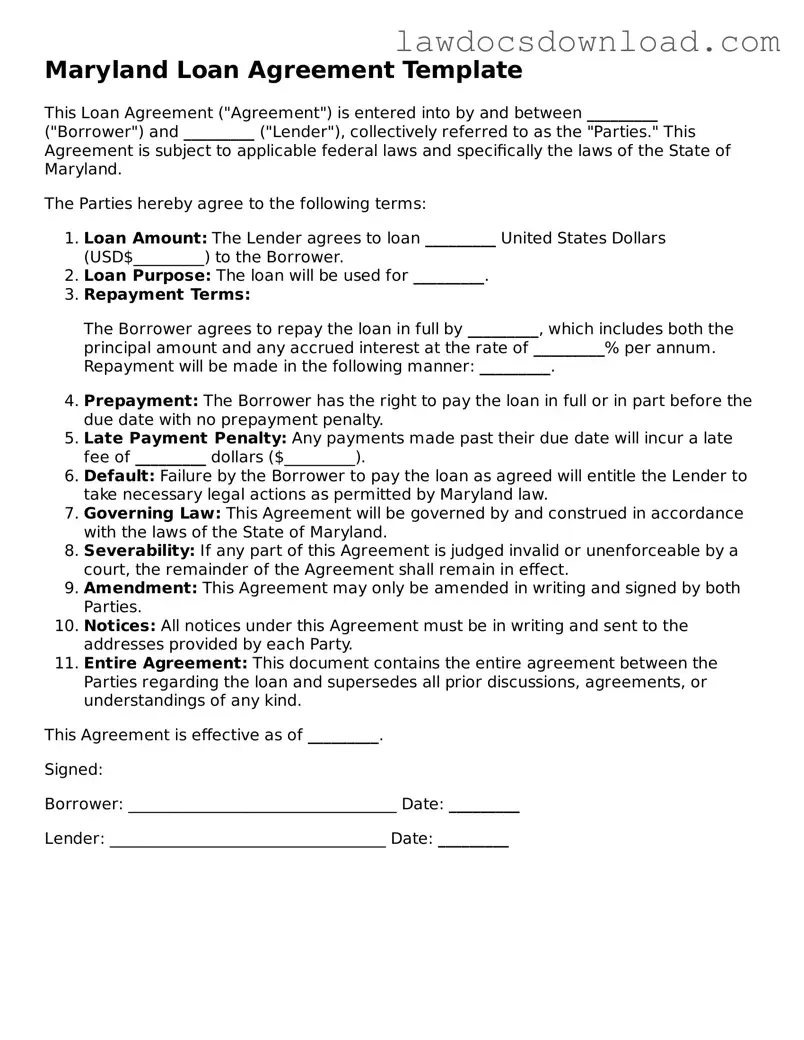The Maryland Loan Agreement form shares similarities with a Promissory Note in that both establish a promise to pay a certain amount of money. A Promissory Note is usually more straightforward and involves fewer details about the repayment structure. It spells out the borrower's promise to repay the lender, often without needing collateral, whereas a Loan Agreement typically includes more detailed provisions such as interest rates, payment schedules, and security interests.
A Mortgage Agreement also shares common ground with the Maryland Loan Agreement, particularly in its function of outlining the terms under which money is borrowed to purchase real estate. The Mortgage Agreement goes a step further by securing the loan against the property being purchased, meaning the lender can foreclose on the property if the borrower fails to make payments as agreed, a level of security that may or may not be present in a generic Loan Agreement.
The Personal Loan Agreement is akin to the Maryland Loan Agreement, with both serving the purpose of documenting the terms under which one party lends money to another. The difference often lies in the relationship between the parties; personal loan agreements typically involve individuals, possibly friends or family. In contrast, the Maryland Loan Agreement might encompass broader professional lending scenarios, including business or commercial loans.
A Car Loan Agreement is specific to financing the purchase of a vehicle, making it similar to the Maryland Loan Agreement when it's used for the same purpose. Both outline the amount borrowed, the repayment schedule, interest rate, and consequences of non-payment. The Car Loan Agreement, however, is tailored specifically towards the purchase of a vehicle and often includes details about the vehicle as collateral.
Student Loan Agreements and the Maryland Loan Agreement form both facilitate the borrowing of money for educational purposes. However, student loan agreements are designed especially for students and usually contain terms reflecting the unique conditions of student loans, like deferment options during school attendance and grace periods after graduation, which aren't typically found in general loan agreements.
The Business Loan Agreement and the Maryland Loan Agreement can overlap when the loan's purpose is to finance business operations or expansion. Both outline the loan's terms, including repayment schedules, interest, and collateral. Yet, business loan agreements often include covenants or agreements reflecting the business’s performance, which might not be relevant or present in more generalized loan agreements.
Credit Agreements, while broad, share the concept of extending credit under specified terms, much like the Maryland Loan Agreement form. Credit agreements, however, can be more complex, covering lines of credit, credit cards, and revolving credit terms, whereas a loan agreement typically covers a single transaction with fixed repayment terms.
The Debt Settlement Agreement parallels the Maryland Loan Agreement in its focus on the aspects of repayment. However, it differs fundamentally in purpose; it is used to renegotiate or settle existing debt under new terms, often for a lesser amount than originally owed, which contrasts with a loan agreement's aim to structure the initial terms of a new loan.
A Co-Signer Agreement is related to the Maryland Loan Agreement in cases where a loan agreement requires the assurance of an additional party. This type of agreement outlines the co-signer's obligations to repay the loan if the primary borrower fails to do so, adding a layer of security for the lender. The main loan agreement defines the borrowing terms, while the co-signer agreement specifies the co-signer’s responsibilities.
Lastly, an Equipment Financing Agreement shares similarities with the Maryland Loan Agreement when the funds are used to purchase equipment. Both documents dictate the terms of financing, including repayment and interest. However, the equipment financing agreement uniquely addresses the specific scenario of acquiring equipment, often including provisions that treat the equipment itself as collateral for the loan.
